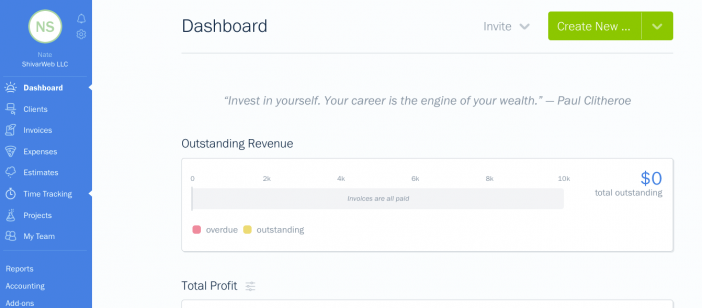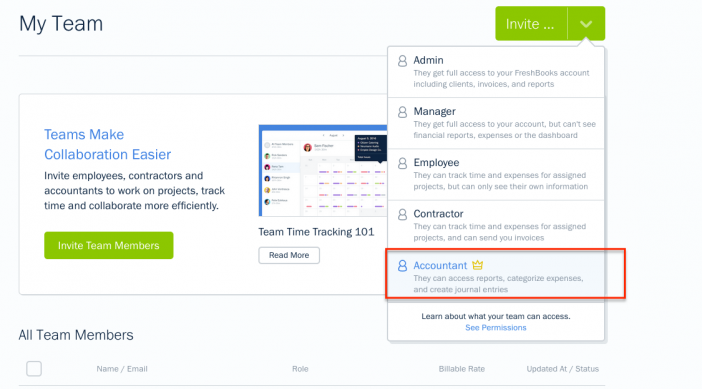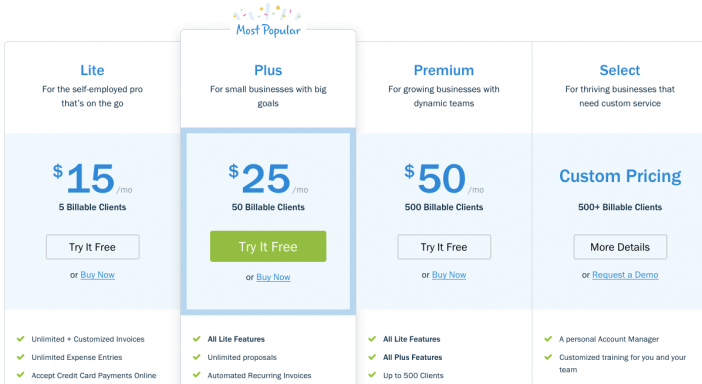I’ve been running a business for more than 10 years now. For the last 9+ years, I’ve been using FreshBooks for invoicing and bookkeeping. It’s also one of the companies on my Resources page that readers ask me most about. I thought I’d convert those emails into a full FreshBooks review for reference – because here’s the thing.
I’ve had 3 bosses at 3 different companies tell me variations of the same idiom. “If it feels tedious, you’re doing it wrong.” Or, “if you’re working hard, you are using the wrong tool.” Or, “if you’re working hard, you’re probably ignoring what’s important.”
Boring stuff like invoicing and bookkeeping aren’t technically part of marketing or improving your or your client’s website. But it does compete for your time and attention. It’s also an easy-time suck.
By 2012, I had been running a freelance marketing & web design business for several years. I was spending way too much time trying to keep costs down while also looking professional and legit. I was using PayPal’s free invoice feature and Google Sheets. It was quite a mess. So I started looking a resource for bookkeeping, invoicing, and a bit of accounting.
I started using FreshBooks. I’ve never used QuickBooks or compared QuickBooks vs. FreshBooks. It seemed feature overkill (and $$$) at the time. But I haven’t left FreshBooks even as business has grown and my career has changed.
BTW – I evaluated it by signing up for a free plan and clicking around. Check out FreshBooks’ free trial & plans here.
I don’t use FreshBooks for anything super-complicated. I use it to:
- Create and send invoices to clients and advertising partners and track their accounts.
- Track and manage expenses.
- Basic accounting (aka looking at P&L sheets & Schedule C documentation).
- Simplify communication with my accountant.
For a while, I kept using the old FreshBooks Classic. But now I’ve fully migrated to the new FreshBooks platform.
So here’s my FreshBooks review with pros & cons. It’s not for everyone, but it’s also not meant to be either.
Pros of Using FreshBooks
Before I get into specific things I like about FreshBooks, here’s the main pro that beats all other things:
FreshBooks reduced my time creating, sending, filing, and tracking invoices & expenses from ~30 minutes per client to ~5 minutes per client/partner. If you value that time on your hourly rate…that is a lot of money.
So whatever bookkeeping platform you use – I’d use that rule as the gold standard. Here are my 3 main pros of FreshBooks.
User-Friendly
Like a lot of trendy, web-only software – FreshBooks has a simple, straightforward user-focused design. It’s colorful. It has personality.
The new version is even more user-friendly than the Classic version (where my screenshots come from) – but FreshBooks has been user-friendly since day one.
It has giant green buttons and a well-thought-out user interface. It’s not overloaded with features like a of desktop-based software.
Here’s what the main dashboard looks like –
80% of my time is spent clicking through to Invoices. 10% is spent on Expenses, and 10% on Reports.
Here’s what a standard invoice screen looks like.
There’s plenty of options. There are pre-filled fields. I like the ability to pre-set rates for different projects and billing items. For example, a 1 Hour Consultation is always $200. To bill a client, I just select them from the drop-down. Click Consultation and click send.
If you need to line-item you can. Everything is pre-filled without being locked down and defined.
Here’s what the Client screen looks like –
When you set up a new client, you just enter their information and they become part of the system.
One quick note is that FreshBooks’ plans factor in your number of clients. So if you have a lot of small one-time clients (and want to stay on the 2 lower priced plans for a while longer), it’s worth “hacking” FreshBooks to have an editable general client. I’ll get to that in the cons.
Either way, FreshBooks’ focus on simplicity and user-friendliness has a very short learning curve. You don’t need to take a course to get started and getting value.
It’s a huge pro for me.
Integrations
Every single business has all sorts of random requirements and needs. And FreshBooks’ doesn’t try to be everything to everybody. However, they have been trying to rapidly grow outside their original wheelhouse of freelancers billing hourly time.
FreshBooks has approached these needs through the ability to integrate simply with all sorts of other platforms, payment systems, and even 3rd party users.
FreshBooks has a flexible API – which means it can “talk” to a lot of other software. That list includes time tracking software, eCommerce software (like WooCommerce), payroll software (like ZenPayroll), and help desk software.
They also have lots of internal add-ons like project time-tracking that you can add or leave off depending on how simple you’d like to keep you own FreshBooks’ setup.
I’m also a fan of how well they integrate with PayPal. Most everyone is familiar and feels secure with PayPal, so collecting invoices is simple. FreshBooks also has their own payments gateway so that you can collect credit/debit directly via FreshBooks (minus transaction fees).
The last integration that I like is 3rd party user integration – aka the invite your accountant functionality. Although FreshBooks does a lot of basic accounting, it clearly can’t build your business tax strategy or any other strategic accounting plans. They did recently roll out integrated payroll though.
Traditionally, discussing tax strategy with your accountant would mean gathering a bunch of documents and giving your accountant a messy view of the business (aka wasting everyone’s time).
With FreshBooks’ invite your accountant functionality, my accountant not only got quick remote access, but also had access to all the right documents in all the right format. Time-saving for everyone.
In short, FreshBooks’ integrations gives me versatility while keeping the overall software simple and uncluttered.
Customizations
On a related pro – I’m fan of how well FreshBooks allows for customization.
Like I mentioned in the intro, I was coming to FreshBooks from a weird mixture of PayPal’s free invoicing software and Google Spreadsheets.
It was not only a bit of a mess, but it didn’t look particularly professional. In hindsight, it worked but it also keep me in the class of “freelancer” instead “consultant.” PayPal allows you to add your logo, but it still looks like PayPal.
FreshBooks invoices can be edited and customized much more fully to look like a professional invoice.
But the customization goes beyond that – like I mentioned in the earlier section, you can customize all the pre-filled sections in the invoicing. You can customize expense rule & categories. With the integrations, you can also customize the process to create invoices.
Cons of Using FreshBooks
Other than doing a few free trials of competitors (see below in Next Steps), I don’t have an across the board experience with various bookkeeping platforms. And even though I’ve stuck around with FreshBooks – I think there are a few things that eliminate FreshBooks from being a fit for everyone.
FreshBooks Pricing
I think the biggest con for FreshBooks is their pricing. Yes, it’s reasonable. And I do think it’s worth it.
However, the month to month fees can add up quickly over the course of a year for functionality that you can technically get for free or cheaper.
Side note – FreshBooks actually has a free invoice creator for one-off projects.
FreshBooks’ pricing is pretty simple – but it hinges on one thing – your number of clients. If you are a freelancer or business getting projects from lots of different clients, then you will quickly get placed in the Plus tier of ~$25 USD per month.
If you are still in a place where you are getting established – that $25/mo is an attractive cost to cut. When I scaled my business down while working for an agency, I did just that. I didn’t leave, but I did delete all my client contacts and left a single, generic, editable “Advertising Partner” to track revenue for my (not client) website projects. I did the same for my few one-off clients. That put me in the $15/mo tier.
That said, if you are doing work with lots of clients that are paying well, the $25/mo is fine. It’s very much justifiable based on time saved. But if you are getting established or doing work with lots of clients with small individual invoices…FreshBooks’ pricing is a con.
Bulk Editing & Creation
Another con that I’m still actively trying to figure out how to solve is bulk creation of invoices within the FreshBooks’ interface.
I usually have several more than a dozen invoices to create at the end of every month all at once. The amounts and projects are unpredictable, so I can’t set them as recurring invoices. They also aren’t tied to any “trigger” like a website purchase that I can set to automatically generate an invoice (something that I am working to change).
Either way – every month, I have to click to create each invoice manually. There’s no way to batch create them, or even open them all in new windows. I have to create each one individually all the way through.
The ironic thing is that if I had a trigger or something to sync with the API – it would be super simple. But in the middle area where I’m at – lots of custom-ish invoices all at once – FreshBooks makes it a bit awkward.
This issue was one reason that I had to roll back to the Classic version at tax time. The new version makes inputting of expenses and invoices much easier, but bulk execution was just too frustrating at the time. Their customer feedback team says that they have fixed this issue for users like me, but I just haven’t pulled the trigger on upgrades yet.
One-offs
FreshBooks also has a couple one-off cons. I would call them bugs if they had only happened once. But I generally have trouble with them once every few months, so I’ll include them here.
Email click-throughs don’t always work
Every few months, I’ll have an invoice that goes to the client. They view it (something that is cool about FreshBooks – a client can’t say they didn’t “see” your invoice). But then they click through to pay…and it crashes.
I haven’t been able to recreate it myself. But it has happened enough with a range of clients – and with long-time clients that I trust and have used FreshBooks – that there is something going on. It’s pretty annoying when it does happen.
Automated Expenses Aren’t Exactly Right
FreshBooks has the ability to sync with your bank and credit card company to automatically pull in expenses. You can also set rules and custom categories. However, FreshBooks’ also tries to automatically tag expenses….and it’s not so smart there.
You can solve this issue to a degree with rules, but editing expenses is still going to be a manual task, about as tedious as a spreadsheet.
Pro Tips on Using FreshBooks
Here’s a few of the lessons I’ve learned over 4+ years to get more out of FreshBooks.
Keep track of advertising revenue with Other Income
Many freelancers will have a side-project with ad revenue from Google AdSense, affiliate partners or ad buys. In the old FreshBooks, everything was set up as “client.” To keep track of ad revenue, I created the partner as a client but used my information.
When I get a payout, I create and save a draft invoice from that partner. Then open the invoice and mark it as paid in full. The revenue will then show up in your books as if you invoiced them for fees that you were paid out – like a reverse invoice system.
In the new FreshBooks, I just use the Other Income tab.
Now – be sure to keep a copy of the actual invoice that is generated in case you ever need to sell or document what is basically a bookkeeping hack – not a professional practice.
Pre-fill all your projects
I underestimated this feature of FreshBooks for a while. But if you do a certain service for a defined rate – add that into FreshBooks. You can then just select it when billing out a client.
Keep a generic “Client” then use the Invoice label to identify small projects.
Like I mentioned in pricing – FreshBooks bases pricing on the number of clients that you have. If you have fewer than 25 regular clients and a few miscellaneous projects mixed in – here’s what I do to save some money. Add a client and call it “Project” – some placeholder. Just edit and re-use that “client” for the miscellaneous projects. When you fill out the invoice, use the description label to name and differentiate clients.
Next Steps
My experience with FreshBooks has been great. It isn’t perfect and it isn’t for everyone. I’d recommend –
- Writing down exactly what you are looking for, how many clients you have, and what your current bookkeeping system is.
- Sign up here for a free trial (they don’t require a credit card) at FreshBooks.
- Spend 15 minutes clicking around. You’ll likely get a quick sense of whether or not they are what you’re looking for.
If you’re looking for alternatives to FreshBooks, I’ve heard a lot about –
- InvoiceNinja – I love all things open-source & self-hosted.
- Sage – A recent startup getting a lot of press.
- QuickBooks – The brand in the space. Recently re-did their platform to be based in the cloud.
- Invoicera – Another one that I tried.
Whatever you decide on – spend less time bookkeeping and more time marketing and improving your website.












